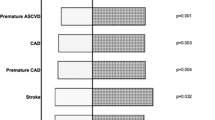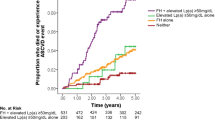Abstract
The familial lipoprotein disorder type III hyperlipoproteinemia (HPL) carries a marked increase in the risk of accelerated and premature atherosclerosis, but there is considerable variation among affected individuals in susceptibility to cardiovascular disease (CVD). We studied the influence of independent risk factors for atherosclerosis in 67 patients with clinically overt type III HPL and homozygosity for apolipoprotein (apo) E2. Among the different risk factors (lipid and lipoprotein levels, age, sex, body mass index, smoking status, hypertension, and diabetes mellitus) there was only a statistically significant difference in age between 25 patients with atherosclerosis and 42 patients without atherosclerosis. Serum lipoprotein (a), [Lp, (a)], levels were 30.6% higher in the atherosclerosis group, but this was not statistically significant. We conclude that (in contrast to familial hypercholesterolemia) elevated Lp (a) concentrations may not be regarded as a component of the clinical syndrome of type III HPL.
Similar content being viewed by others
References
Assmann G, Lenzen HJ (1985) Apolipoprotein E-Polymorphismus, Hyperlipidämie und Herzinfarktrisiko. Internist (Berlin) 26:692–700
Berg K (1963) A new serum type in man — the Lp system. Acta Pathol Microbiol Scand 59:369–382
Berg K, Dahlén G, Frick MH (1974) Lp (a) lipoprotein and prebeta1-lipoprotein in patients with coronary heart disease. Clin Genet 6:230–235
Boerwinkle E (1992) Genetics of plasma lipoprotein (a) concentrations. Curr Opin Lipidol 3:128–136
Boerwinkle E, Menzel HJ, Kraft HG, Utermann G (1989) Genetics of the quantitative Lp (a) lipoprotein trait III. Contribution of Lp (a) glycoprotein phenotypes to normal lipid variation. Hum Genet 82:73–78
Carlson LA, Hamsten A, Asplund A (1989) Pronounced lowering of serum lipoprotein Lp (a) in hyperlipidaemic subjects treated with nicotinic acid. J Intern Med 226:271–276
Conover WJ (1980) Practical nonparametric statistics. 2nd edn, John Wiley & Sons, New York
Feussner G, Schuster H (1992) Screening for the apolipoprotein B-100 arginine3500→glutamine mutation in patients with type III hyperlipoproteinemia. Clin Genet 32:302–305
Guyton JR, Dahlen GH, Patsch W, Kautz JA, Gotto AM Jr (1985) Relationship of plasma lipoprotein Lp (a) levels to race and to apolipoprotein B. Arteriosclerosis 5:265–272
Havel RJ, Eder HA, Bragdon JH (1955) The distribution and chemical composition of ultracentrifugally separated lipoproteins in human serum. J Clin Invest 34:1345–1353
Hazzard WR, Warnick GR, Utermann G, Albers JJ (1981) Genetic transmission of isoapolipoprotein E phenotypes in a large kindred: relationship to dysbetalipoproteinemia and hyper lipidemia. Metabolism 30:79–88
Mahley RW, Rall SC Jr (1989) Type III hyperlipoproteinemia (dysbetalipoproteinemia): the role of apolipoprotein E in normal and abnormal lipoprotein metabolism. In: Scriver CR, Beaudet AL, Sly WS, Valle D (eds) The metabolic basis of inherited disease, 6th edn. McGraw-Hill, New York, pp 1195–1235
Mbewu AD, Bhatnagar D, Durrington PN, Hunt L, Ishola M, Arrol S, Mackness M, Lockley P, Miller JP (1991) Serum lipoprotein (a) in patients heterozygous for familial hypercholesterolemia, their relatives, and unrelated control populations. Arterioscler Thromb 11:940–946
Rhoads GG, Dahlen G, Berg K, Morton NE, Dannenberg AL (1986) Lp (a) lipoprotein as a risk factor for myocardial infarction. JAMA 256:2540–2544
Sandholzer C, Hallman DM, Saha N, Sigurdsson G, Lackner C, Csásár A, Boerwinkle E, Utermann G (1991) Effects of the apolipoprotein (a) size polymorphism on the lipoprotein (a) concentration in 7 ethnic groups. Hum Genet 86:607–614
Sandholzer C, Feussner G, Brunzell J, Utermann G (1992) Distribution of apolipoprotein (a) in the plasma from patients with lipoprotein lipase deficiency and with type III hyperlipoproteinemia. No evidence for a triglyceride-rich precursor of lipoprotein (a). J Clin Invest 90:1958–1965
Scanu AM, Fless GM (1990) Lipoprotein (a) heterogeneity and biological relevance. J Clin Invest 85:1709–1715
Schneider WJ, Kovanen PT, Brown MS, Goldstein JL, Utermann G, Weber W, Havel RJ, Kotite L, Kane JP, Innerarity TL, Mahley RW (1981) Familial dysbetalipoproteinemia: abnormal binding of mutant apolipoprotein E to low density lipoprotein receptors of human fibroblasts and membranes from liver and adrenals of rats, rabbits and cows. J Clin Invest 68:1075–1085
Schriewer H, Assmann G, Sandkamp M, Schulte H (1984) The relationship of lipoprotein (a) [Lp (a)] to risk factors for coronary heart disease. J Clin Chem Clin Biochem 22:591–596
Seed M, Hoppichler F, Reaveley D, McCarthy S, Thompson GR, Boerwinkle E, Utermann G (1990) Relation of serum lipoprotein (a) concentration and apolipoprotein (a) phenotype to coronary heart disease in patients with familial hypercholesterolemia. N Engl J Med 322:1494–1499
Soma M, Fumagalli R, Paoletti R, Meschia M, Maini MC, Crosignani P, Ghanem K, Gaubatz J, Morrisett JD (1991) Plasma Lp (a) concentration after oestrogen and progestagen in postmenopausal women. Lancet 337:612
Thiery J, Armstrong VW, Schleef J, Creutzfeld C, Creutzfeld W, Seidel D (1988) Serum lipoprotein Lp (a) concentrations are not influenced by an HMG CoA reductase inhibitor. Klin Wochenschr 66:462–463
Utermann G (1987) Apolipoprotein E polymorphism in health and disease. Am Heart J 113:433–440
Utermann G (1989) The mysteries of lipoprotein (a). Science 246:904–910
Utermann G (1990) Genetics of the Lp (a) lipoprotein. In: Scanu AM (ed) Lipoprotein (a): 25 years of progress. Academic Press, New York, pp 75–85
Utermann G, Vogelberg KH, Steinmetz A, Schoenborn W, Pruin N, Jaeschke M, Hees M, Canzler H (1979) Polymorphism of apolipoprotein E. II. Genetics of hyperlipoproteinemia type III. Clin Genet 15:37–62
Utermann G, Hoppichler F, Dieplinger H, Seed M, Thompson G, Boerwinkle E (1989) Defects in the low density lipoprotein receptor gene affect lipoprotein (a) levels: multiplicative interaction of two gene loci associated with premature atherosclerosis. Proc Natl Acad Sci USA 86:4171–4174
Warnick GR, Mayfield C, Albers JJ, Hazzard WR (1979) Gel iso electric focusing method for specific diagnosis of familial hyperlipoproteinemia type 3. Clin Chem 25:279–284
Wiklund O, Angelin B, Olofsson S-O, Eriksson M, Fager G, Berglund L, Bondjers G (1990) Apolipoprotein (a) and ischaemic heart disease in familial hypercholesterolemia. Lancet 335:1360–1363
Zannis VI, Breslow JL (1981) Human very low density lipoprotein apolioprotein E isoprotein polymorphism is explained by genetic variation and posttranslational modification. Biochemsitry 20:1033–1041
Author information
Authors and Affiliations
Rights and permissions
About this article
Cite this article
Feussner, G., Wagner, A. & Ziegler, R. Relation of cardiovascular risk factors to atherosclerosis in type III hyperlipoproteinemia. Hum Genet 92, 122–126 (1993). https://doi.org/10.1007/BF00219678
Received:
Revised:
Issue Date:
DOI: https://doi.org/10.1007/BF00219678




